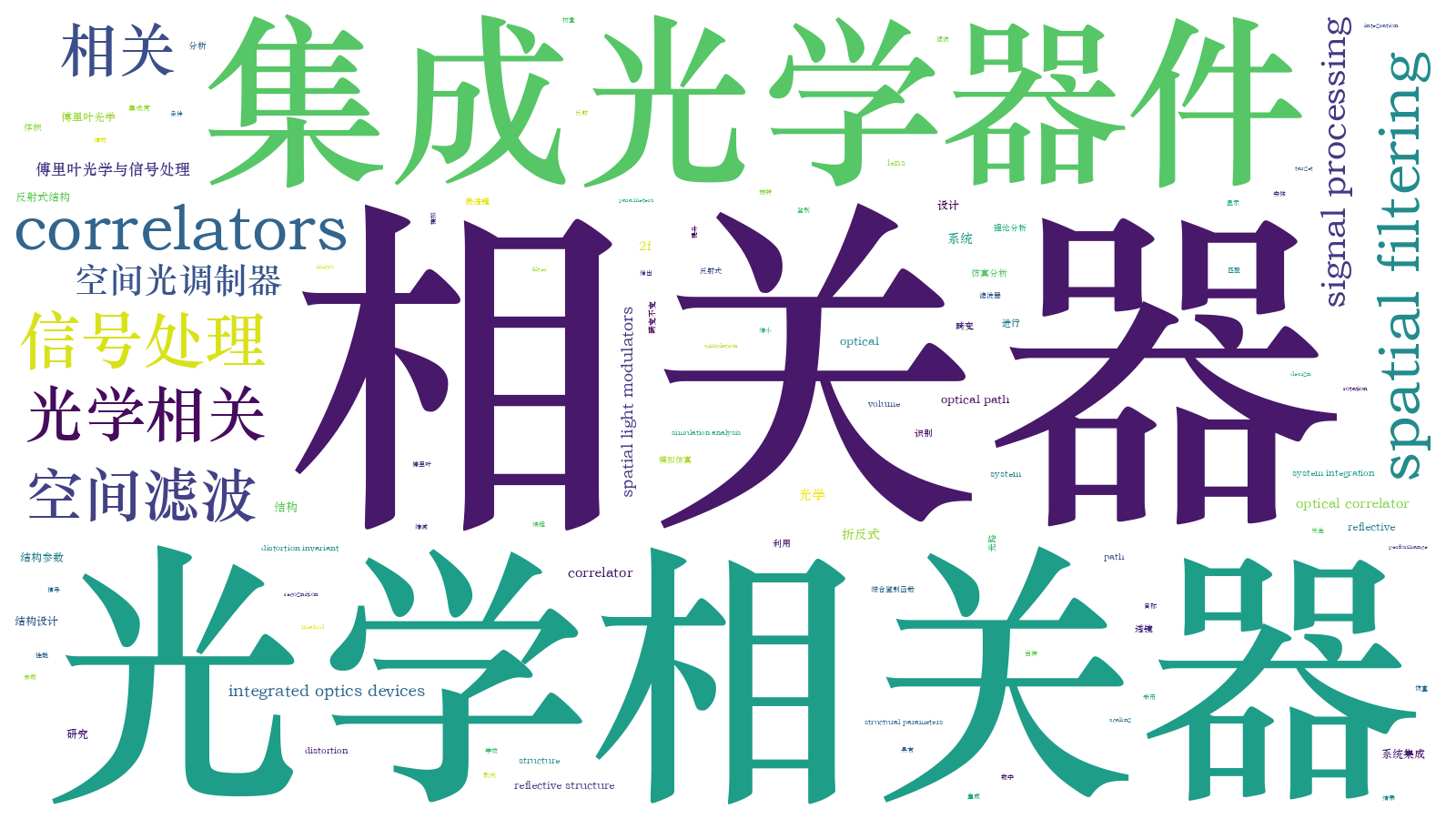折反式2f 系统光学相关器的研究
1 引言
4
相关器系统中的滤波器对系统的识别能力起到至关重要的作用,性能优良的匹配滤波器对各种畸变目标均能输出尖锐的相关峰。优化折中综合鉴别函数滤波器(OTSDF)[16]综合多种滤波[17-20]的优势,可以使输出相关峰平均相关高度最大,提高畸变图像集整体相关峰高度;使平均相似度值尽可能小,从而提高滤波器的畸变容限;使平均相关能量尽量小,以便减少相关峰旁瓣,提高中频信息的通过率;使噪声方差尽量小,以便提高滤波器抗噪声特性,主要抑制输入高频噪声[21]。因此OTSDF可以识别输出的相关峰强度、相关峰形态、畸变容限和抗噪声等,对不同畸变目标能输出高质量且相对稳定的相关峰,这对畸变目标的准确识别和判断非常有利。
目前相关器依旧存在集成度低、对准精度要求高、畸变不变识别能力弱等问题,本文根据文献[
22-27]设计了折反式2
2 折反式2f系统光学相关器结构及理论分析
折反式2
折反式2
针对折反式2
式中
入射光沿倾斜坐标系传输时,通过SLM1后的光场分布可以表示为
光束从SLM1后表面到达SLM2前表面的传播距离为
即在SLM2前表面得到输入目标的傅里叶变换,令光束通过SLM2,即经过匹配滤波器与透镜后,在SLM2的后表面的光场分布可以表示为
式中
根据菲涅耳衍射公式,输出面(CCD接收面)的光场分布可表示为
式中
式中F{·}为傅里叶变换,
为使后续实验方便,选取相关器的工作波长为632.8 nm,其中主要器件有CCD和纯相位反射式空间光调制器,空间光调制器分辨率为1080 pixel×1080 pixel,像素大小为8 μm×8 μm。
根据上述对相关器结构的理论分析及实验条件,为使其结构体积尽可能小,所设计的折反式2
SLM1上的数字微透镜1的焦距大小等于SLM1到SLM2的距离,并且等于SLM2到CCD的距离,SLM1和CCD关于SLM2上的透镜2成共轭关系,则有
由(8)式可以得到
表 1. 折反式2f相关器结构参数
Table 1. Folding reflective 2f correlator structure parameters
|
3 折反式2f系统光学相关器仿真分析
相关器的识别能力主要由匹配滤波器的性能决定,畸变容限大的匹配滤波器能够使相关器的畸变不变识别范围增大,从而提升系统在实际应用中的稳定性和对畸变待识别目标的识别能力。针对折反式2
使用Elaine图片为例作为输入待识别目标。

图 3. (a)识别缩放畸变目标输出相关峰CPI变化曲线; (b)识别旋转畸变目标输出相关峰CPI变化曲线; (c)识别旋转缩放同时存在畸变目标输出相关峰CPI变化曲线
Fig. 3. (a) Curve of the CPI varies with the scaling object; (b) curve of the CPI varies with the rotation object; (c) curve of the CPI varies with the scaling and rotation object
(-40°,+40°)范围的畸变目标进行仿真识别,从识别输出的相关峰CPI分布可知,相关峰CPI的数值整体变化不大,基本都保持在0.8以上。仿真结果表明,使用折反式2
针对折反式2
4 结论
设计了一种折反式2
[4] SolusD, OvsenikL, TuránJ. Optical correlator in vertical traffic signs inventory system[C]. IEEE 13th International Scientific Conference on Informatics, 2016: 15701280.
SolusD, OvsenikL, TuránJ. Optical correlator in vertical traffic signs inventory system[C]. IEEE 13th International Scientific Conference on Informatics, 2016: 15701280.
SolusD, OvsenikL, TuránJ. Optical correlator in vertical traffic signs inventory system[C]. IEEE 13th International Scientific Conference on Informatics, 2016: 15701280.
[6] Callaghan MJ, Perlmutter SH, WoltB. Single-chip correlator implementation for PCI-bus personal computers[C]. SPIE, 2000, 4043: 48- 58.
Callaghan MJ, Perlmutter SH, WoltB. Single-chip correlator implementation for PCI-bus personal computers[C]. SPIE, 2000, 4043: 48- 58.
Callaghan MJ, Perlmutter SH, WoltB. Single-chip correlator implementation for PCI-bus personal computers[C]. SPIE, 2000, 4043: 48- 58.
[7] 刘文耀, 张以谟, 董世洪, 等. 集成化光学相关器及匹配滤波器的优化设计[J]. 光学学报, 2000, 20(12): 1680-1683.
刘文耀, 张以谟, 董世洪, 等. 集成化光学相关器及匹配滤波器的优化设计[J]. 光学学报, 2000, 20(12): 1680-1683.
刘文耀, 张以谟, 董世洪, 等. 集成化光学相关器及匹配滤波器的优化设计[J]. 光学学报, 2000, 20(12): 1680-1683.
[9] 刘加勇, 徐平, 徐海东, 等. 新型平面集成光学相关器设计与分析[J]. 光学学报, 2008, 28(9): 1735-1739.
刘加勇, 徐平, 徐海东, 等. 新型平面集成光学相关器设计与分析[J]. 光学学报, 2008, 28(9): 1735-1739.
刘加勇, 徐平, 徐海东, 等. 新型平面集成光学相关器设计与分析[J]. 光学学报, 2008, 28(9): 1735-1739.
[10] 徐海东, 徐平, 亓森林, 等. 基于4f结构平面集成相关器系统优化[J]. 光学学报, 2010, 30(4): 1002-1008.
徐海东, 徐平, 亓森林, 等. 基于4f结构平面集成相关器系统优化[J]. 光学学报, 2010, 30(4): 1002-1008.
徐海东, 徐平, 亓森林, 等. 基于4f结构平面集成相关器系统优化[J]. 光学学报, 2010, 30(4): 1002-1008.
[20] Mahalanobis A, Kumar B. Unconstrained correlation filters[J]. Applied Optics, 1994, 33(17): 3751-3759.
Mahalanobis A, Kumar B. Unconstrained correlation filters[J]. Applied Optics, 1994, 33(17): 3751-3759.
Mahalanobis A, Kumar B. Unconstrained correlation filters[J]. Applied Optics, 1994, 33(17): 3751-3759.
[29] 周亮, 喻珺, 杨拓, 等. 匹配滤波识别相关峰的分析与实验判别[J]. 光学学报, 2016, 36(9): 0907001.
周亮, 喻珺, 杨拓, 等. 匹配滤波识别相关峰的分析与实验判别[J]. 光学学报, 2016, 36(9): 0907001.
周亮, 喻珺, 杨拓, 等. 匹配滤波识别相关峰的分析与实验判别[J]. 光学学报, 2016, 36(9): 0907001.
Article Outline
杨拓, 徐平, 周亮, 喻珺, 李雄超, 黄海漩. 折反式2








